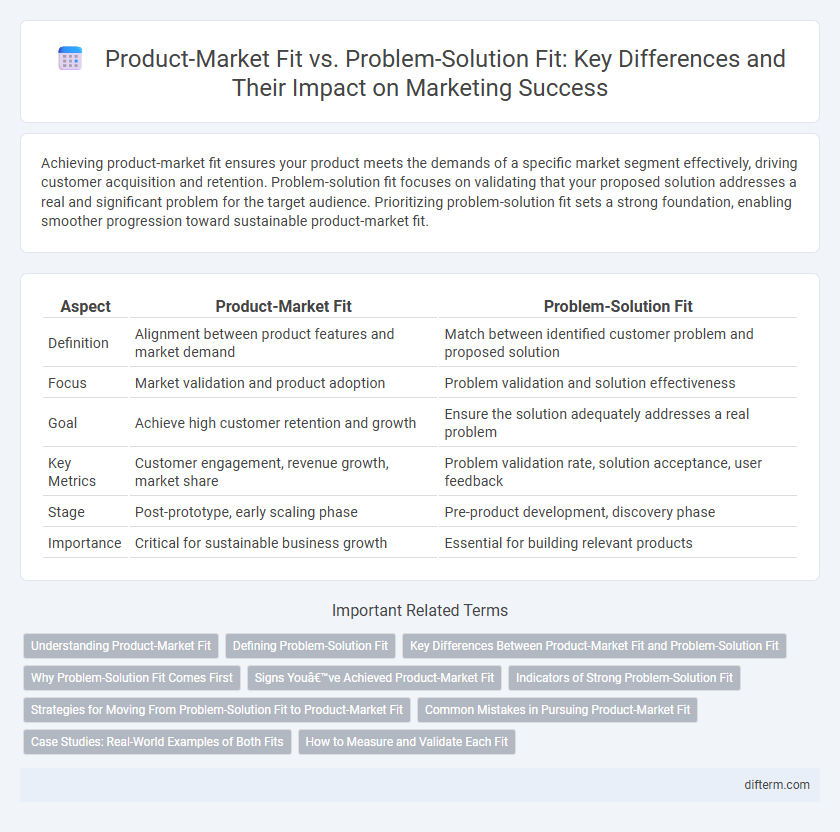Achieving product-market fit ensures your product meets the demands of a specific market segment effectively, driving customer acquisition and retention. Problem-solution fit focuses on validating that your proposed solution addresses a real and significant problem for the target audience. Prioritizing problem-solution fit sets a strong foundation, enabling smoother progression toward sustainable product-market fit.
Table of Comparison
| Aspect | Product-Market Fit | Problem-Solution Fit |
|---|---|---|
| Definition | Alignment between product features and market demand | Match between identified customer problem and proposed solution |
| Focus | Market validation and product adoption | Problem validation and solution effectiveness |
| Goal | Achieve high customer retention and growth | Ensure the solution adequately addresses a real problem |
| Key Metrics | Customer engagement, revenue growth, market share | Problem validation rate, solution acceptance, user feedback |
| Stage | Post-prototype, early scaling phase | Pre-product development, discovery phase |
| Importance | Critical for sustainable business growth | Essential for building relevant products |
Understanding Product-Market Fit
Product-market fit occurs when a product satisfies a strong market demand, indicating that customers recognize its value and are willing to pay for it. It requires not only addressing a specific problem but also aligning with target audience needs, behaviors, and purchasing power. Understanding product-market fit involves analyzing customer feedback, retention metrics, and market traction to ensure scalable growth opportunities.
Defining Problem-Solution Fit
Problem-solution fit occurs when a product effectively addresses a clearly identified customer problem, demonstrating that the solution is desirable and viable before scaling. Achieving problem-solution fit involves deep customer discovery, validating pain points, and iterating product features based on real user feedback. This alignment ensures the product resonates with target users, setting a strong foundation for pursuing product-market fit and sustainable growth.
Key Differences Between Product-Market Fit and Problem-Solution Fit
Problem-solution fit establishes that a product effectively addresses a validated customer problem, confirming demand before scaling. Product-market fit occurs when the product satisfies market needs at scale, demonstrating strong customer adoption and business growth potential. Key differences lie in timing and focus: problem-solution fit validates value proposition early, while product-market fit confirms widespread market acceptance and traction.
Why Problem-Solution Fit Comes First
Achieving problem-solution fit is essential because it validates that a solution effectively addresses a core customer problem, ensuring genuine demand before scaling. Without confirming this fit, pursuing product-market fit risks developing features that may not resonate with users or solve their pain points. Prioritizing problem-solution fit streamlines resource allocation and accelerates product iteration based on real user feedback and needs.
Signs You’ve Achieved Product-Market Fit
Achieving product-market fit is signaled when customer retention rates increase consistently, indicating genuine demand and satisfaction. Metrics such as rapid revenue growth, low churn, and positive user feedback highlight alignment between the product's features and target market needs. Strong word-of-mouth referrals and high engagement rates validate that the solution effectively addresses core market problems.
Indicators of Strong Problem-Solution Fit
Strong problem-solution fit is indicated by a clear understanding of customer pain points and solutions that directly address those specific needs, demonstrated through positive user feedback and early adopters' engagement. Key metrics include high customer satisfaction scores, frequent usage patterns, and low churn rates, signaling that the product effectively solves the identified problem. This alignment ensures a solid foundation before scaling toward product-market fit, guiding iterative improvements based on real user insights.
Strategies for Moving From Problem-Solution Fit to Product-Market Fit
Achieving product-market fit requires validating the problem-solution fit by deeply understanding customer pain points and iterating a minimum viable product based on direct user feedback. Employ data-driven strategies such as customer segmentation, usage analytics, and A/B testing to tailor features that meet market demands and scale adoption. Prioritize building scalable customer acquisition channels and refining value propositions to align with evolving market needs and competitive landscapes.
Common Mistakes in Pursuing Product-Market Fit
Common mistakes in pursuing product-market fit include rushing to scale before validating the problem-solution fit, which leads to misaligned products and wasted resources. Founders often prioritize features over understanding customer pain points, resulting in low adoption and churn. Ignoring early customer feedback and failing to iterate rapidly further hinder achieving true product-market fit.
Case Studies: Real-World Examples of Both Fits
Case studies reveal that achieving problem-solution fit involves deeply understanding customer pain points, as demonstrated by Airbnb's early focus on addressing travelers' need for affordable lodging. Product-market fit is exemplified by Slack, which refined its platform based on user feedback to become essential in team communication across diverse industries. These real-world examples highlight how iterative user validation drives successful alignment between products and market demands.
How to Measure and Validate Each Fit
Measuring product-market fit involves tracking key metrics such as customer retention rates, Net Promoter Score (NPS), and revenue growth to ensure the product resonates with the target market. Validating problem-solution fit requires qualitative feedback through customer interviews, surveys, and observing early adoption patterns to confirm the solution effectively addresses user pain points. Using a combination of these quantitative and qualitative data points enables marketers to iteratively refine their strategy and align the product with market needs.
Product-market fit vs problem-solution fit Infographic

 difterm.com
difterm.com